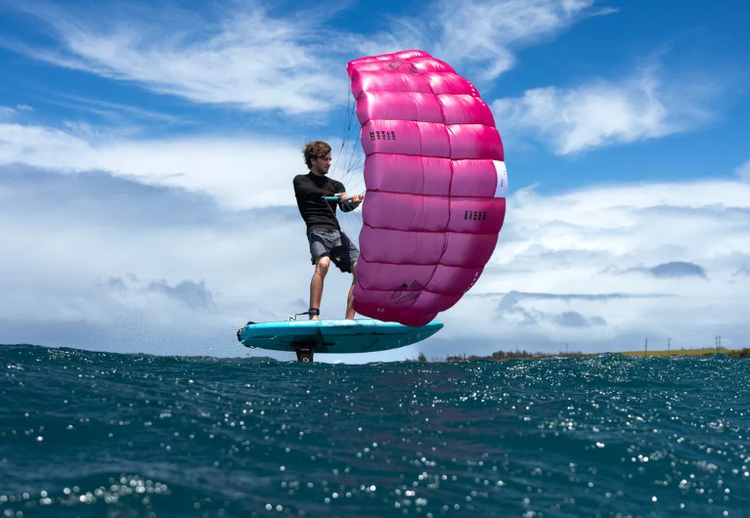Parawing 101
Parawing is an innovative water sport that combines elements of wing foiling, downwind foiling, kite foiling, and paragliding. This new discipline uses a small, compact wing similar to those used in paragliding to capture wind power, enabling riders to either travel upwind or simply get up on the foil and ride waves and swell downwind without continuous wind or paddle assistance, yes you heard me - hands free!! The parawing is designed to be stowed in a waist-attachable pouch when not in use.
Origin and Inspiration
The first prototypes emerged in Hawaii, born from foil surfers looking for an alternative to paddle downwinding (paddle-ups). Downwind paddling is notoriously challenging, requiring extensive stamina and skill. The goal was to eliminate paddling from the downwinding equation. Wing foiling was already an alternative, but it presented its own challenges : constant wing management; hand switching, getting backwinded and interrupted wave riding…
The breakthrough came when they pioneered parachutes designed to swiftly lift riders onto foil, then cleverly stow away – and thus, the parawing was born. Another alternative was also invented during this journey to simplify foil surfing/downwinding, the Foil Drive. A battery powered foil assist to get you on foil without a paddle or wind assistance! We’ll go into foil assist in the next blog 🙂

Key Features of Parawing
Equipment
-
Parawing
- Typically around 3 to 5 square meters, which is connected to a short bar via lines.
- Designed to be compact and lightweight making it easy to pack away once you get on foil.
- For beginners, we recommend a smaller parawing paired with an oversized board and foil.
-
Foilboard Options
- Beginners: Large, buoyant boards like a SUP or downwind foilboard for stability and reduce drag
-
Intermediates/Advanced: Smaller midlength boards ranging (45 to 80 liters) based on skill and body weight.
- Hydrofoil Selection
Most hydrofoils used for wing foiling or downwind foiling are suitable for parawing foiling. However, your choice should be tailored to your skill level, body weight, local conditions, and riding goals.
For the best parawing/downwind experience, a high-aspect, wide wingspan foil is recommended. These foils are designed for efficient gliding, making it easier to link bumps and ride swells with minimal power from the wind.
Beginner Setups - Beginners are advised to start with larger front wings (typically 1300–1540 cm²) and higher-volume boards (around 100L or more). This combination offers more lift at lower speeds, making it easier to get up on foil and maintain stability. As you progress, you can move to smaller, more agile foils for increased speed and maneuverability.
Advanced Setups - Experienced riders may opt for smaller foils (700- 960 cm²) for higher speeds and sharper turns, especially in stronger wind conditions and larger swell. However, these require refined technique and are zero forgiving during takeoff and low-speed maneuvers.
Matching Foil to Parawing Conditions
|
Rider Level |
Foil Size (Front Wing) |
Board Volume |
Best Use Case |
|
Beginner |
1300–1540 cm² |
100L+ |
Easy lift, stability |
|
Intermediate |
900–1300 cm² |
80–100L |
Versatility, progression |
|
Advanced |
<1000 cm² |
60–80L |
Speed, maneuverability |
NOTE : In lighter winds (<16mph (15 kt)), larger foils and wings are necessary for sufficient lift. In strong winds (>30mph (25 kt)), smaller foils and wings help maintain control and avoid having too much lift.
Pro Tips
-
Avoid starting with too small a foil can make takeoff and control difficult, especially for beginners or in gusty conditions.
-
Leash Use - Always use a board leash for safety.
- Packability - Consider a waist belt or pouch for easy stowage.

Unlike traditional wing foiling, the parawing can be easily stowed in a waist pouch, freeing your hands and allowing for uninterrupted wave and swell riding. The parawing can be quickly relaunched after a fall, providing immediate power to get back on foil.
Benefits and Advantages
- Efficiency: Enables surf foiling without extensive paddling
- Freedom and Glide: Provides pure and unobstructed gliding experience
- Accessibility: It offers an alternative to paddling, wing foiling and foil assist as an entry point for downwind foiling.
-
Versatility: Use it like a kite or a wing; have the ability to go upwind and jibe!
Challenges and Considerations
Wind & Learning Conditions
- Best learned in winds of at least 15 knots (16 mph)
- Recommended wing size: 3-4 meters depending on your size; so there isn’t too much canopy to manage.
- Requires multiple wing sizes to adapt to varying wind conditions
Safety
While relatively safe due to its compact nature and proximity to the rider, ongoing developments to improve safety features like Parawing leashes. We recommend you wear a helmet and an impact vest or approved floatation device as well as a board leash during your sessions.
Target Audience
Parawing is currently a niche discipline primarily focused on wave and swell catching. As the sport continues to evolve, the Parawing's full potential is still unfolding – and with top kitesurfing brands embracing this innovation in 2025, it's poised to revolutionize the game!
Will people just sail around like in wing foiling or kite foiling? Maybe. It is much less efficient than kite and wing foiling in conditions without waves. Nonetheless, Parawinging could have interesting applications in snow sports like an alternative to snowkiting and winging on the snow.
- Competent Foilers
- Downwind enthusiasts
- Those with wind knowledge (Kiter/Windsurfer/Winger)
- Those seeking a unique wave riding experience

Wing foiling VS. Parawing | Why One Over the Other?
|
Aspect |
Parawing |
Wing Foiling |
|
Design |
Compact, lightweight, parachute-like, stowable |
Inflatable, handheld, rigid. Not designed to be packed away & redeployed mid-session |
|
Primary Use |
Optimized for downwind foiling |
Versatile for various conditions (upwind, downwind, flat water) |
|
Wave Riding |
Hands-free surf foiling after initial pop up |
Requires continuous wing management |
|
Ease of Relaunch |
Quickly relaunchable from a pouch |
More challenging if deflated |
|
Portability |
Extremely compact |
Bulkier setup, less portable |
|
Wind Efficiency |
Smoother, faster downwind rides |
Consistent propulsion, requires more maneuvering and control |
Conclusion
Parawinging represents an innovative approach to wind and wave sports, providing you with a unique, hands-free riding experience. As technology and techniques develop, this emerging discipline promises exciting possibilities for foiling enthusiasts. Head to greenhatkiteboarding.com and get involved in this new sport, we think you'll be stoked about it!

